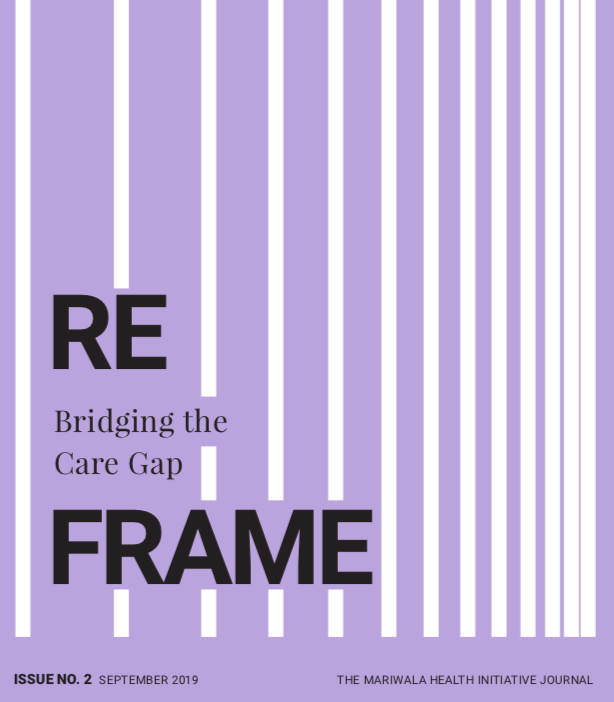ReFrame: Editor's Note
Note from the Editor
This is the second issue of ‘ReFrame’, a journal through which we endeavor not only to transform existing discussions around mental health (MH), but also to widen the scope for participation in these crucial conversations. Our last issue highlighted the need for funding rights-based MH work, given that the MH sector has not been a priority in philanthropy or CSR in India.
As I sat down to write this note, I received a forward from one of the most prestigious global media houses, seeking to talk to people who had “suffered mental health issues, taken medical help and achieved something big in her life ... in areas like sports, arts...” Such messages reinforce the dubious but widespread assumption that “inspirational” narratives about persons with mental illness being “productive” against all odds will help reduce stigma. Anti-stigma campaigns, used worldwide for over 60 years now, have tended to communicate people’s experiences of mental health in a particular way – promoting “cures” and “recoveries”. In similar vein, statistics (that the mainstream media like to quote) about the “treatment gap” suggest that the number of persons with mental health concerns denotes a demand for mental health services that outstrips supply, due to a lack of qualified MH professionals. Such approaches reflect dominant notions about MH, with their narrow focus on diagnosis, drugs, and experts who “fix” problems – on cure, rather than care.
Are these useful lenses to employ as we work towards mental health for all? The treatment gap, anti-stigma campaigns, and indeed the psy disciplines themselves are, in India, largely borrowed – and applied in cut-and-paste fashion – from Western discourse and practice. Yet how does each fit into the sociopolitical and economic structures, and environmental forces in our part of the world? Does the ensuing emphasis on the individual mean that failure to be cured is an individual failure? Are “expert” voices the only ones that matter? And does everyone need an expert to work through their mental distress?
The “treatment gap” is hardly the main problem for the country’s MH sector, with its lack of respect for informed consent, blatant human rights violations, and policy stasis. We believe we need to question the expert-driven biomedical model so that we might consider systemic changes in how we see, define, and respond to mental illness. This is why the theme for this year’s edition is ‘Bridge the Care Gap’.
The journal is divided into three sections. The first, ‘Re-vision’, explores paradigm shifts in the psy disciplines. Pathways to Mental Health by Pathare et al foregrounds the concept of the “care gap” by highlighting some critical policy, advocacy, and service interventions that emerge when we look beyond the “treatment gap” model. Other articles examine ethical considerations within, and the queering of, the MH establishment, critiquing the role of psychiatry in defining norms, and in othering multiple persons and bodies. AK Dave and S Jain et al challenge predominant ideas of “recovery” – one, based on lived experiences; another, based on community-based mental health work – and ask: who do we exclude when we put out positive stories of recovery?; and, are we talking of recovery in ways that make sense in our social contexts?
How do we foreground lived experiences and knowledge from the margins in transforming our MH system, which is still saddled with approaches derived from the old Western standard for normalcy, that of an able-bodied cis-heterosexual male? The second section, ‘Contexts’, brings us voices of persons oppressed or marginalized in multiple ways, even within the MH establishment. I Walk the Line delves into the experiences of service users; Enhancing Livelihoods, written by P Thiruselvi, has recommendations based on her experience as a survivor of mental illness and homelessness, and as a counselor. Once the label of mental illness is affixed, what does it take to access basic citizenship rights? One article recounts the work involved in getting voting rights for persons living in a mental health institution. Additionally, we see how a reductive biomedical approach further invisibilizes and pathologizes, as Deepa Pawar speaks of collective trauma in communities that face caste-related violence, and Nidhi Goyal writes on the mental health gap for persons with physical and sensory disabilities.
While the first two sections offer nuanced critiques of prevalent, hegemonic approaches to MH, the section, ‘Engage’, highlights on-the-ground practices and experiences that foreground the idea of the “mental health care gap”. Some articles narrate examples of reformulating curricula, and MH advocacy campaigns; others such as Pattie Gonsalves talk of working with varied stakeholders such as youth, and Surendranath et al of mental health within the criminal justice system. The underlying question is: how do we create local systems for MH support and services, while challenging the need for experts? Two specific programs are discussed: Fostering Resilience in the Wake of Disasters relates to MH preparedness in communities that live in disaster-prone areas; the other, The Atmiyata story on community-based rural mental health. Both these pieces reveal how communities may learn – and are potentially the best placed – to become agents for their own collective mental health.
Individually and together, these articles help us interrogate and disrupt dominant MH paradigms. Throughout, there also runs the surely unsettling (for many) indication that mental illness diagnoses are often deeply connected to social norms, or ideology, and may thus be subjective. I believe these pieces encourage us to look more closely at how the intersections of poverty, casteism, misogyny, and other forms of violence impact mental health, and to locate MH within economic, environmental, sociocultural, and political contexts.
- R. Mariwala
